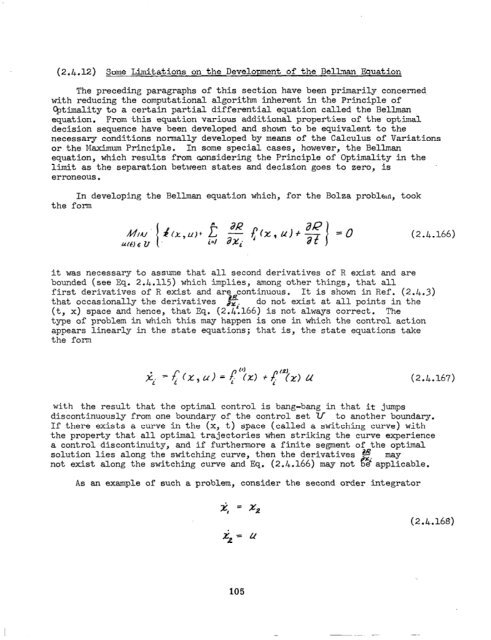guidance, flight mechanics and trajectory optimization
guidance, flight mechanics and trajectory optimization
guidance, flight mechanics and trajectory optimization
You also want an ePaper? Increase the reach of your titles
YUMPU automatically turns print PDFs into web optimized ePapers that Google loves.
(2.4.12) Some Limitations on the Development of the Bellman Equation<br />
The preceding paragraphs of this section have been primarily concerned<br />
with reducing the computational algorithm inherent in the Principle of<br />
C@timality to a certain partial differential equation called the Bellman<br />
equation. From this equation various additional properties of the optimal<br />
decision sequence have been developed <strong>and</strong> shown to be equivalent to the<br />
necessary conditions normally developed by means of the Calculus of Variations<br />
or the Maximum Principle. In some special cases, however, the Bellman<br />
equation, which results from considering the Principle of Optimality in the<br />
limit as the separation between states <strong>and</strong> decision goes to zero, is<br />
erroneous.<br />
In developing the Bellman equation which, for the Bolza probleln, took<br />
the form<br />
it was necessary to assume that all second derivatives of R exist <strong>and</strong> are<br />
bounded (see Eq. 2.4.115) which implies, among other things, that all<br />
first derivatives of R exist <strong>and</strong> are continuous. It is shown in Ref. (2.4.3)<br />
that occasionally the derivatives 2% do not exist at all points in the<br />
(t, x) space <strong>and</strong> hence, that Eq. (2.4'.166) is not always correct. The<br />
type of problem in which this may happen is one in which the control action<br />
appears linearly in the state equations; that is, the state equations take<br />
the form<br />
(2.4.166)<br />
(2.4.167)<br />
with the result that the optimal control is bang-bang in that it jumps<br />
discontinuously from one boundary of the control set 7-f to another boundary.<br />
If there exists a curve in the (x, t) space (called a switching curve) with<br />
the property that all optimal trajectories when striking the curve experience<br />
a control discontinuity, <strong>and</strong> if furthermore a finite segment o$Ethe optimal<br />
solution lies along the switching curve, then the derivatives - may<br />
not exist along the switching curve <strong>and</strong> Eq. (2.4.166) may not f%'applicable.<br />
As an example of such a problem, consider the second order integrator<br />
% = x2<br />
?2 =U<br />
105<br />
(2.4.168)

















